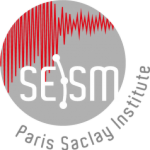Location: CentraleSupélec | Université Paris-Saclay, France
Keywords: Structural Health Monitoring, Finite Element Method, wave propagation, structural vibration / acoustics, reinforced concrete, signal processing, digital twin.
Starting date: anytime
Duration: until Nov. 2023
Contat: pierre.jehel@centralesupelec.fr (Pierre Jehel, PhD)
This post-doctoral position is open in the framework of the project GEOPONT that aims at developing a reliable and cost-effective technique for the health monitoring of reinforced concrete bridges. The project GEOPONT gathers 2 industrial partners (Bouygues Travaux Publics and SpotLight) and 1 public institution (CentraleSupélec | Université Paris-Saclay). It is financially supported by the CEREMA in the framework of the France 2030 Plan of the French government (https://www.cerema.fr/fr/pontsconnectes).
The post-doctoral researcher will be conducting research to numerically model the propagation of artificially generated seismic waves in reinforced concrete bridge slabs. Bridgology will provide Ground Penetrating Radar (GPR) images from a couple of bridges that are currently in service in the Greater Paris area. SpotLight will then carry out experimental invistigations on these same bridges, generating a source of artificial seismic waves and recording how these waves propagate in the bridge slab using geophone sensors. CentraleSupélec will be developing a numerical model of the bridge decks and of the waves propagation to support the design of experiments and also to support the analysis of the experimental results.
The bridge slabs will be modeled using the finite element method. The initial state of the bridge will be determined from the data collected by the GPR. Uncertainty in the material properties will be introduced using stochastic fields. The experiments carried out on site will be modeled numerically.
The main objective is to develop a numerical mechanical model that accurately represents the experimental measures. Such a model can then be used for (i) the interpretation of experimental observations, (ii) the design of new experiments, (iii) the structural health monitoring of a category of bridges. In particular, several questions will have to be investigated:
• How to define the finite element mesh and its boundary conditions?
• Can the slab heterogeneous material (steel rebars, cement paste, aggregates) be considered as homogeneous? How to define a Representative Elementary Volume?
• What are the conditions (if any) for the results obtained from the numerical analysis of a specific bridge to be valid for another bridge?
• How to communicate the results of the computations in terms of quantities of interest for the bridge owner?
• How to develop a learning numerical framework where the results of new experimental campaigns can improve the accuracy of the bridge numerical model? Model updating strategies could be implemented to improve the predictive capabilities of the numerical model towards achiving digital twins of
the bridges investigated.
References:
Moustapha M., Marelli S., Sudret B. (2022) Active learning for structural reliability: Survey, general framework and benchmark, Structural Safety 96: 102174.
Fuhg J.N., Fau A., Nackenhorst U. (2021) State-of-the-Art and Comparative Review of Adaptive Sampling Methods for Kriging, Archives of Computational Methods in Engineering 28: 2689-2747.
Shinozuka M., Deodatis G. (1991) Simulation of stochastic processes by spectral representation, Applied Mechanics Reviews 44(4): 191-204.
Mankara A., Bayane I., Sørensen J.D., Brühwiler E. (2019) Probabilistic reliability framework for assessment of concrete fatigue of T existing RC bridge deck slabs using data from monitoring, Engineering Structures 201: 109788.

